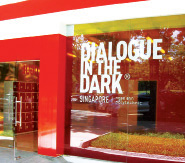What is it like to live in complete darkness? City News sends a reporter to Dialogue In The Dark, an exhibition one never gets to see.
 |
|
| PHOTOS: Dialogue In The Dark | |
Some have felt instant nausea, others, extreme fear. One visitor even passed out midway and had to be carried back into the light.
But this was no horror show I was stepping into, and my guide wasn’t Frankenstein.
Wesley has been legally blind for all of his 40 years, and he was about to introduce me to his world.
Curiosity led me to Dialogue in the Dark Singapore, the first permanent exhibition of its kind in Southeast Asia, and the only one to be strategically located within an educational institution—Ngee Ann Polytechnic.
“We want to change mindsets. We want to promote empathy, and not sympathy, for the visually-impaired,” said Glen Ng, project manager of the social enterprise, which offers employment for the blind as well as experiential learning experiences and research opportunities. Visitors are led in small groups through a series of ordinary situations in complete darkness, helped by a blind guide.
 Robbed of my most adept sense, I could see (pun intended) why many found it unnerving. Poised in the precarious dark, I could not help feeling that one misstep would send me freewheeling into an unexpected void. Sightlessness is a messy, cacophonous affair, where the most mundane of sounds and textures become magnified and alien. Cold water running through my fingers, the rough skin of a pineapple, the buttons of an ATM machine—these seemed somehow more real, but not as precious as the reassuring solidity of the long white cane in my fingers.
Robbed of my most adept sense, I could see (pun intended) why many found it unnerving. Poised in the precarious dark, I could not help feeling that one misstep would send me freewheeling into an unexpected void. Sightlessness is a messy, cacophonous affair, where the most mundane of sounds and textures become magnified and alien. Cold water running through my fingers, the rough skin of a pineapple, the buttons of an ATM machine—these seemed somehow more real, but not as precious as the reassuring solidity of the long white cane in my fingers.
 “Come toward my voice,” Wesley repeated patiently and often. His voice became my compass during the hour-long tour, and I found the role-reversal fascinating. Disability, I was now keenly aware, is truly a social construct. Simple tasks, like navigating a street curb, climbing aboard a boat, and sticking a straw into a juice box, confounded me, yet Wesley breezed through them because he saw his world in a different way.
“Come toward my voice,” Wesley repeated patiently and often. His voice became my compass during the hour-long tour, and I found the role-reversal fascinating. Disability, I was now keenly aware, is truly a social construct. Simple tasks, like navigating a street curb, climbing aboard a boat, and sticking a straw into a juice box, confounded me, yet Wesley breezed through them because he saw his world in a different way.
Wesley shared that every guide has a unique style of bringing visitors through the tour, so most repeat guests gain new experiences. He said he enjoyed his work immensely because of its unique challenges and rewards, and is especially heartened when visitors tell him they see with renewed color and treasure their eyes more after the experience.
Mostly, he hopes that the exhibition will become an iconic regional attraction like its foundation stone in Germany, which has attracted over six million visitors since its opening in 1988. The social enterprise has also provided jobs for more than 6,000 blind people.
So far, the numbers have been encouraging. Dialogue in the Dark Singapore officially launches on April 28 this year, but already almost 1,000 tour groups, some as big as 10 people each, have passed through its doors. Wesley has guided children as young as seven, elderly and disabled in wheelchairs, and tourists.
At the end of the tour, I was relieved to be back in the light, although not entirely sorry that my guide would never emerge from his darkness. I now understood how multi-dimensional his world was. It’s likely that few exhibitions will impact you as much as the one you cannot see.
Without giving too much of the game away, here are some useful tips for new adventurers:
• Wear sneakers with a decent grip. You do not want to be stumbling around on mud or other uneven terrain in stilettos.
• Bring dollar notes in smaller denominations. This reduces embarrassing confusion when you have to make transactions in the dark.
• Do not wear glow-in-the-dark accessories or nail polish. You will be asked politely but firmly to remove them!
For more information about Dialogue in the Dark Singapore, go to www.dialogue-in-the-dark.com.
